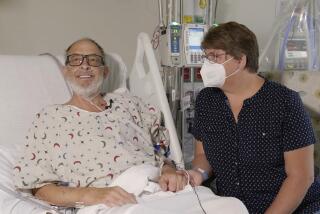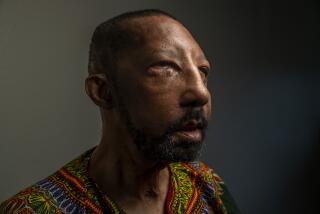Parents’ Gift of Life : Medicine: One year later, family celebrates successful lung transplant that made medical history.
- Share via
During the first weeks of 1993, Stacy Sewell, then 21, was fighting for every breath.
A doctor warned Jim and Barbara Sewell that their daughter was about to lose her lifelong battle with cystic fibrosis.
But a year ago last Saturday, all three members of the Sewell family took part in a risky medical experiment that snatched Stacy from death’s door. At USC University Hospital, a team supervised by Dr. Vaughn Starnes removed parts of Jim’s and Barbara’s lungs and sewed them into Stacy’s chest.
It was the first time two living donors had been used in a lung transplant and the first lung transplant performed on a cystic fibrosis patient. The operation raised medical ethics questions because it put three lives in jeopardy at one time.
Yet today there are no regrets in the Sewell house, located on a scenic rise in Quartz Hill, just west of Lancaster. On the anniversary of the historic operation, the family popped open a bottle of champagne they had received a year earlier from a member of the transplant team.
And this afternoon, the family will return to the hospital to join Starnes, other staff members and other transplant families in an anniversary celebration.
The Sewells have good reason to celebrate. Although they are sometimes winded by heavy exertion, Jim, 56, and Barbara, 50--who each gave up one lobe--say it has not affected their normal routines.
But the most remarkable change is in Stacy. Before the surgery, she was tethered to an oxygen machine around the clock, sometimes too weak to wash her hair. Today, she plays tennis, works 20 hours a week at a clothing store, attends college and stays out till 2 a.m. with friends.
“A year ago, she was sick and dying,” Jim Sewell said. “Today, she is alive and healthy and has a life ahead of her. It is a completely different person.”
Cystic fibrosis, an inherited disorder that affects about 30,000 Americans, causes thick, sticky mucus to build up in the lungs. This leads to chronic lung infections and the destruction of critical air sacs.
Since the Sewells’ operation, Starnes has performed six successful transplants involving cystic fibrosis patients and their living relatives. But few doctors nationwide have followed suit because the technique is still new and poses some risks to the living donors.
The Cystic Fibrosis Foundation in Washington has taken no position on this surgery and refers inquiries to leading physicians in the field.
Previously, lung transplants only involved organs from recently deceased donors. But about 1,200 people nationwide are on a waiting list, and a patient typically must wait more than a year for a transplant, experts say.
Living-donor operations are an option when a patient cannot wait a year. But transplant experts say they only work when the recipient is smaller than the donors. In these cases, the two small donated lobes provide normal lung capacity for the recipient.
No one disputed that Stacy Sewell was days away from death just over a year ago. Even so, her family says, Stacy possessed a powerful will to live and a knack for beating the odds.
She had confounded her doctors’ prediction that she would die before her first birthday, her mother says. After a difficult childhood, her health improved as a teen-ager. When she graduated from Quartz Hill High in 1990, most of her classmates were unaware of her ailment.
But by late 1992, her health had taken a turn for the worse, forcing her to leave her job and college. By then, Stacy was so weak that her father had to carry her upstairs to her room, piggyback style.
Today, Stacy, a petite woman with wavy brown hair, says she was most upset about the loss of independence. “I did not like the way my life was,” she said. “I didn’t like being dependent on so many people, and I didn’t like being housebound.”
By January, 1993, Stacy was hospitalized with a dangerously fast heartbeat, caused by her failing lungs. Because of her grave condition, Starnes asked Stacy’s parents to consider a living-donor transplant.
But he warned that because Stacy was so weak, she had only a 50-50 chance of surviving the surgery. Her mother now says, “At no point during this did we really think she wouldn’t make it. We never stopped to think that she might die.”
After the operation, when Stacy was disconnected from a respirator, “I felt like I was breathing with somebody else’s body,” she said. Although Jim Sewell was discharged in 10 days, his wife developed an infection that required additional surgery. She remained in the hospital for five weeks.
“I still feel guilty to this day,” Stacy told her mother recently. “What you went through was awful.”






